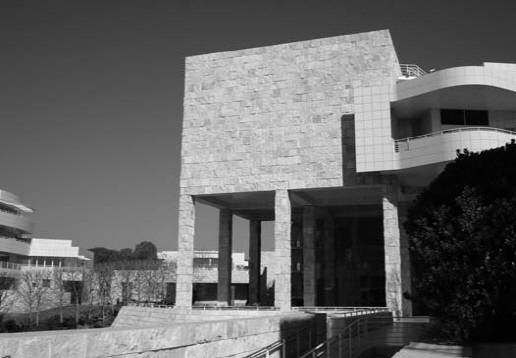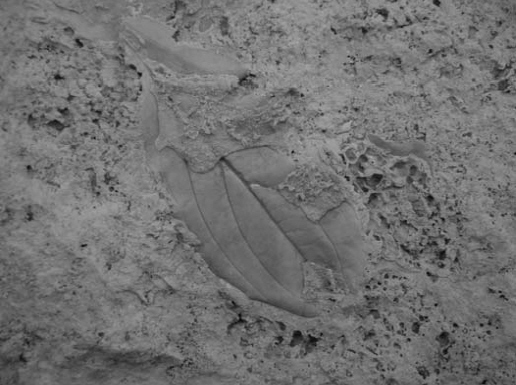Stories in Stone (38 page)
Authors: David B. Williams

No place better exemplifies the use of travertine as a building stone in the United States than the Getty Center in Los Angeles.
Designed by Richard Meier and built between 1984 and 1997, the Getty incorporates 290,000 travertine panels to cover the multibuilding
complex of museum galleries, restaurant and café, auditorium, research institute, and conservation institute.
All of the stone
came from the deposits at Bagni di Tivoli.
13
The roughly one million square feet of travertine ranges from 71.2-by-71.2-inch paving blocks to fifty-by-ninety-inch picture,
or feature, stones, as architect Richard Meier termed the largest panels.
He scattered them throughout the complex, often
at eye level, in order to “provide a heightened awareness of the material.”
14
The Getty sits on a high ridge just west of Interstate 405 as it heads north from Westwood and up to Sepulveda Pass.
Parking
is underground in the multilevel garage.
A travertine-floored elevator carries you up to the tram station and platforms of
travertine.
Since visitors cannot drive up to the Getty Center, most everyone parks in the garage and takes the 41.2-minute
ride on an electric tram up the hill.
Meier has described the tram ride as elevating visitors “out of their day-to-day experience” and “at the same time, they’ll
have a powerful sense of being in the center of this great city.”
15
Perhaps he meant that being stuck in a vehicle with a top speed of ten miles per hour would give you that true, L.
A.-traffic-jam
feeling.
The tram rolls quietly for three-quarters of a mile through the chaparral vegetation of the Santa Monica foothills to the
summit, 881 feet above the Pacific Ocean.
Detramming occurs in the arrival plaza, a flat, open square with three pines and
a large sculpture, titled “That Profile.” Map-wielding docents meet the trams.
They may also offer umbrellas, not for rain,
but for sun.
In the summer, umbrellas must be essential, as the sun blasts and bakes the travertine.
The plaza is the first introduction to travertine in all its splendor.
The walls are unlike any other travertine building
stones in the country.
Most of the thirty-by-thirty-inch blocks have a rough surface and look like sepia-tone aerial photos
of the desert southwest with miniature mesas, plateaus, valleys, and ridges.
Although most of the blocks are the color of
lightly toasted sourdough bread, some have highlights ranging from brownish orange to black, which enhance the three-dimensionality
of the panels.
The color results from oxidized iron.

The Getty Center, Los Angeles.
Because Meier associated the normal cut of travertine—which sliced the stone perpendicular to the bedding—with building lobbies,
he wanted a different look for his stone.
He achieved it by cutting the Getty’s travertine along the bedding planes, akin
to opening a deck of cards and seeing the faces.
“We wanted the stone to look like stone when viewed from the freeway,” said
Michael Palladino, who ran Meier’s Los Angeles office during the construction of the Getty.
16
“Up close typical travertine looks nice, but from a distance it looks like wallpaper.”
“The process was fairly simple.
We would cut thirty-inch by thirty-inch by eight-foot-long sausages and shove them through
the guillotine.
The blade would fall and break the stone along its weakest point.
We never knew exactly where it would split,”
said Palladino.
The initial piece would be eight to ten inches thick, too thick to hang as veneer, so it would be cut down
to thinner slices forming two façade stones and two to four pavers.
“We were pretty proud of ourselves for figuring out how
to cut the stone into so many pieces, but we were still way over budget,” he said.
Despite such cost-cutting measures the
total cost of the Getty complex ended up being $1 billion.
Meier didn’t originally plan on using travertine.
He is best known for his metal panels, always white, which he has described
as the “most wonderful color because within it you can see all the colors of the rainbow.”
17
The Getty’s neighbors, including the powerful Brentwood Homeowners Association, however, didn’t buy such a flowery description
of white.
For six years, they wrestled with the Getty over the project.
In the end, the two sides agreed to a building permit
with 107 conditions, one of which banned Meier from working in white.
Other requirements mandated a sixty-five-foot height
restriction for buildings and that dirt could neither leave nor get shipped to the site.
Meier described the neighbors’ attitude
as “we don’t want to see you, we don’t want to hear you, and we don’t want to smell you.”
18
“The landscape also dictated that we use stone,” said Palladino.
“It is raw and rugged.
We could either chop the hills and
drop them flat or leave the topography and use this architectural element to connect the buildings to the land.” If they had
used metal, he added, it would have given the buildings a more pristine look and created an object quality; the buildings
would appear to have settled into the landscape.
“Stone, in contrast, would give a sense of the buildings rising from the
land,” he said.
“We also wanted to give the Getty a sense of history and stability.
We wanted to ground the institution, even
though it was a young organization.”
Palladino’s observations are a bit ironic.
In order to build the museum, the Getty shipped a hundred boatloads of travertine
across the Atlantic Ocean, through the Panama Canal, and up the Pacific Ocean to Los Angeles.
How strong is the connection
to landscape, considering that the central grounding force, the travertine, had to travel halfway around the world to connect
the museum’s structures to place?
I don’t mean to single out the Getty for what they did; builders and architects have been
shipping stone willynilly around the world for centuries.
Such trade will not stop, and even seems to be increasing with new
stones from exotic locales appearing every day, but transporting building stones has an environmental impact that builders
and architects should consider.
To start the process of finding the right stone, Palladino sent notes out to stone suppliers asking them to send panels to
the Meier office near UCLA.
“This generated a whole lot of interest,” he said.
They literally had to rent a warehouse to store
the hundreds and hundreds of samples.
He and Meier eliminated 75 percent of the stone based on color, realizing after a more
careful study and exploration of the site that they wanted a stone similar to the natural buff-colored rock on the building
site.
Several stones stood out but were eliminated because they were too expensive or the quarry couldn’t provide the quantity or
provide it fast enough.
“One quarry was excavating by hand.
They couldn’t have gotten enough rock to us in a hundred years,”
said Palladino.
They finally chose the travertine, in part because of the persuasiveness of Carlo Mariotti, the late father of the present
owners of the Tivoli quarry.
On a visit to Rome, Palladino and Meier had noticed rough-cut, nonbedded travertine used as decorative
elements in buildings.
They realized that this was the texture they were looking for, but no one had ever used this cut of
travertine for a façade, particularly for a large project like the Getty.
Mariotti convinced them he could cut the stone to
show the rough surfaces.
It took a year to develop the giant cleaver, dubbed Big Bertha, to cut the vertical slabs.
Carlo Mariotti was also the man responsible for supplying stone for many of the travertine buildings in the United States.
19
In 1958 he provided the stone for Ludwig Mies van der Rohe’s Seagram Building.
Although Mies used travertine only in the
plaza and entryway, it provided a classic contrast to the modernism of the glass tower.
More fame for travertine came between
1962 and 1968, when architects such as Philip Johnson and Eero Saarinen clad Lincoln Center for Performing Arts in travertine
from Mariotti’s quarries.
Most major cities in the United States contain at least one building dressed in travertine.
Architects often use travertine
as van der Rohe did, in foyers, as flooring and accents, the Sears Tower in Chicago and the former World Trade Towers being
good examples.
(The Towers’ architect, Minoru Yamasaki, who coincidentally went to the same high school in Seattle as I did,
had a close friendship with Carlos Mariotti and used his travertine in buildings in Japan, Boston, and Seattle.) The first
travertine most people encounter in Los Angeles is on the walls and floors of LAX airport.
The Mariotti quarry and factory still use Big Bertha and its accompanying machinery.
American architects, however, do not
employ the cleft stone.
“Big-name American architects won’t work with it because they consider it to be ‘Meier’s stone.’ Architects
from other countries, however, don’t have the ego problem and we sell a lot of it to builders in the Middle East,” said Fabrizio
Mariotti, who along with his brother Primo now runs the family business.
20
As you wander the Getty and walk up to any wall of travertine, you will probably find fossil leaves in the cleft stone.
They
look like poplar, ivy, and dogwood and are so detailed and well preserved you can pick out individual veins and stems and
tell if the leaf was upside down or right side up when it fossilized.
A few even appear to have been torn or partially eaten,
perhaps by leaf miner insects, prior to fossilization.
The leaves look as if you can simply peel them off the wall.
The fossiliferous panels are ubiquitous: Meier thoughtfully placed many of the best in popular locations or in places such
as along stairs where you have to move slowly.
Some slabs have only a few leaves, but many have leaves piled atop each other.
On the leaf-rich panels, the leaves face in all directions, just what to expect of leaves that fell in a shallow lake and
collected together in the ooze on the bottom.
Fabrizio referred to this phenomenon as seeing “autumn 20,000 years ago.”
21
The autumnal feeling is enhanced where beautiful bronze and brown California live oak leaves have dropped next to the fossil
leaves.
Not all of the travertine is sourdough colored.
In the main entry to the museum buildings, Meier chose a chocolaty travertine
to provide a contrast between the exterior and interior.
A couple of panels, particularly ones near the bathrooms, feature
an unusual set of fossils.
One looks like a mini–Milky Way Galaxy, another like a tiny spaceship, complete with thrusters,
and a third resembles a snail.
Less than one-half inch wide, the white to tan fossils had been snails, most likely land-based
species that had fallen into the water.

Close-up of leaf fossil at the Getty Center, Los Angeles.
The most amazing panel at the Getty and the coolest part of the entire complex is one of Meier’s feature stones.
It is on
the backside of a wall in the arrival plaza, directly opposite the tram station.
The ninety-by-fifty-inch panel juts out ten
inches from the surrounding panels and is the most stunning panel of building stone I have seen anywhere.